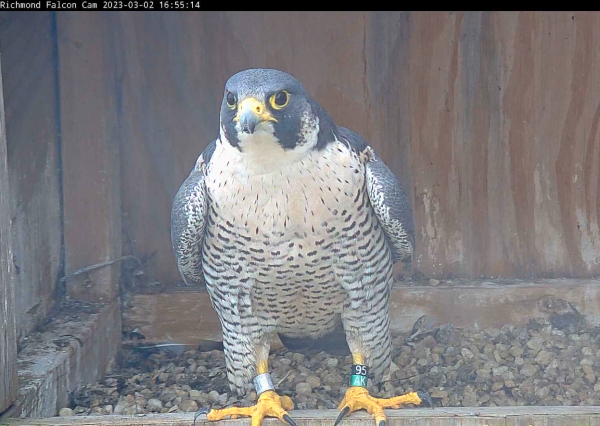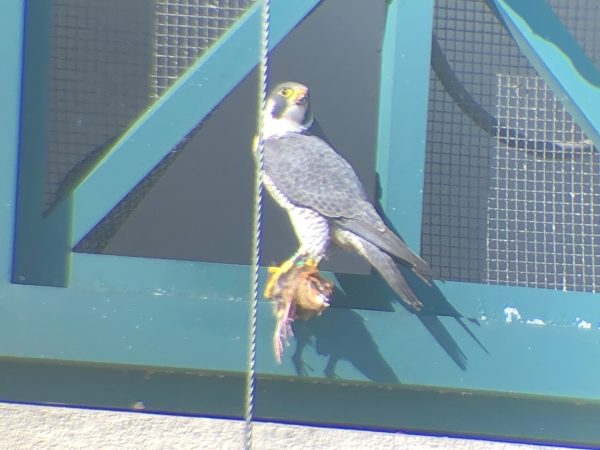Flights, Camera, Action!

95/AK perches on the lip of the nest box on March 2nd, 2023.
Falcon Fans across the Commonwealth can rejoice as the 2023 season of the RVA Falcon Cam is officially underway! We are especially grateful to our partners at Comcast Business who are generously providing us with the internet connection needed to operate the camera for the seventh year in a row.
We are kicking off the 2023 season with updates on the status of last years’ pair as well as two of their offspring from 2021.
We have observed both 95/AK (the reigning female since 2019) and 59/BM (the reigning male since 2021) on camera nearly every day throughout the past month. In addition to perching in their favorite locations, we have also seen them participating in pair bonding and courtship — a great indication that eggs will likely be laid sometime in mid to late-March. Relative to the turnover in breeding adults that we have observed in recent years, we are happy to see some stability at the site once again. The original Richmond pair nested at this location for over a decade so while the outcome of this and future seasons ultimately remains unknown, we are optimistic that 95/AK and 59/BM will continue to utilize this site for many years to come.

The female, 95/AK (left) and the male, 59/BM (right) in the nest box. This image was captured in 2021, which was 59/BM’s first year in Richmond.
As always, we invite you to follow along with us as we cover the events of what will hopefully be another successful season! And remember, if you want to receive falcon updates directly to your inbox, you can join our subscriber list on out our Falcon Cam homepage. This page also includes links to our FAQs as well as archived posts that outline the events of previous seasons.
UPDATES FROM THE 2021 BROOD
Some Falcon Fans may remember the ‘Fab Four’ from 2021. This brood was produced and reared by the current pair and their hatching marked the first time that we had four falcon chicks at the Richmond site in over a decade.
On October 17th, 2022 one of the female fledglings (referred to as ‘Yellow’ based on the color of the tape affixed to her leg bands) was found grounded with a wing injury in Cherry Hill, New Jersey (approximately 210 miles from the Richmond nest box). She was taken to a wildlife rehabilitation center within the state where she unfortunately perished approximately one week later. A necropsy was conducted which led rehabilitators to suspect that she had obtained her injuries from a collision with either a vehicle or a building.
You may recall that this bird fledged with a plastic guard attached to her tail following a collision with a Richmond building and subsequent stint at The Wildlife Center of Virginia. Although Yellow was still wearing the guard when we last saw her, repeated observations of her in the month following her re-release indicated that the guard was not impacting her flight and would likely fall off naturally in the coming weeks. As predicted at the time, the guard did fall off as it was not present when Yellow was picked up in New Jersey as a second-year adult.

‘Red’ delivers a prey item to the female peregrine. These food deliveries are an important part of the pair bonding process.
While saddened by the loss of this bird, we are able to share some happy news as we have continued to receive updates (Thanks Mitch and Melissa!) on ‘Red’, one of Yellow’s male siblings. As reported in September of 2022, Red had been observed in the vicinity of another known peregrine breeding site at the Berkeley Bridge in Norfolk, Virginia. His detection at this location followed the death of another male peregrine who had bred at the site since at least 2019.
Not only has Red continued to hold onto the territory (as opposed to being displaced by other males) but it appears the female has accepted him as her new mate based on their interactions within the area of the nest box.
While it is still too early to tell, we remain optimistic that he will go on to contribute to the greater peregrine population by producing his first-ever clutch this spring.

